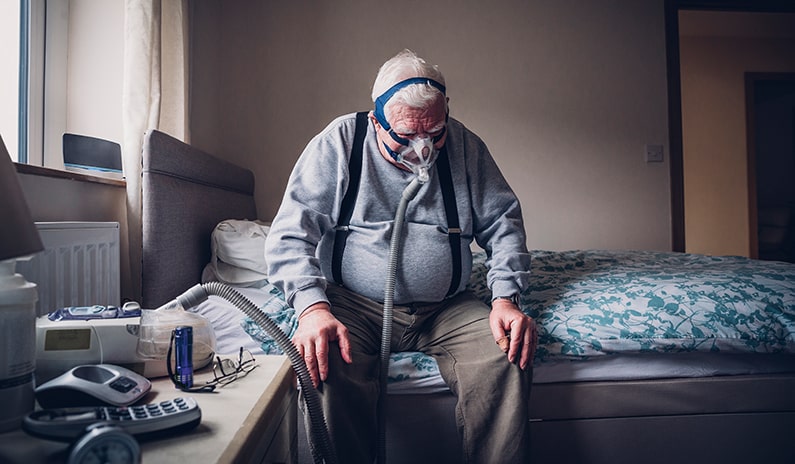Congratulations to your patient! Your patient has just been successfully intubated. But now you have to find the perfect ventilation setting for your patient. I’ll tell you how to do that in this blog post.
Choose from only 3 basic settings
As an anaesthetist and intensive care physician, I’m now telling you: there are only THREE ventilation modes. You don’t believe it? Then read on …
Ventilation option #1: Spontaneous breathing / CPAP
By far the easiest option you have if your patient can still breathe independently and sufficiently. Strictly speaking, a CPAP „ventilation setting“ does not represent real ventilation. Your patient has to do all the breathing alone.
What is a CPAP?
CPAP stands for „Continuous positive airway pressure“. In English: „Continuous positive airway pressure“. If you select this ventilation setting, your patient’s spontaneous breathing during inhalation and exhalation is combined with a permanent positive pressure. The overpressure is also called PEEP. (positive end expiratory pressure).
The advantages of CPAP
ventilation During inhalation the functional residual capacity of your patient is increased. This means that the amount of air that remains in the lungs after exhalation is increased. Furthermore, the collapse of the small airways and alveoli is prevented as best as possible. This prevents the formation of atelectases. The bottom line is that oxygenation is improved and the work of breathing is reduced.
Doctors pay attention:If you choose the CPAP setting, check at short intervals whether your patient always breathes sufficiently. If your patient stops breathing, he or she will not be ventilated and may die in the worst case.
Ventilation Option #2: Positive Pressure Ventilation (PCV)
As the first possibility of an invasive ventilation setting, I will explain positive pressure ventilation to you. With PCV ventilation, your patient is really ventilated. So your patient should either be unconscious and no longer breathe or be anaesthetised so deeply that he can be ventilated.
3 Parameters must be set for positive pressure ventilation:
Parameter 1: The upper pressure level
Usually the pressure level is indicated in mmHg – i.e. mm mercury column. Start here with 15 mmHg as the upper pressure levelfor adults.
Parameter 2: The PEEP (the lower pressure level)
PEEP is the pressure that remains in the lungs after a ventilation stroke. For you this means that the PEEP represents the lower pressure level. Select 5 mmHg PEEP as the standard setting.
Professional tip:You have to be careful especially with heart failure patients and heart attack patients. You may have to reduce the PEEP to 0 mmHg here, as the PEEP leads to an increase in afterload in the right ventricle. I.e. the heart work is strongly increased by high PEEP values.
Parameter 3: Ventilation frequency
Here you can set how often your patient should be ventilated per minute. The default setting for adults is 12 x per minute.
Ventilation Option #3: Volume controlled (VC)
As the oldest invasive form of ventilation I would like to introduce you to volume controlled ventilation. Here a certain adjusted ventilation volume is administered X times per minute.
3 parameters must be set for the volume controlled ventilation:
Parameter 1: The ventilation volume
Here you can set the default setting for your adult to 400 millilitresfor the time being. The ideal calculated breath volume is calculated from the formula 6 times body weight. I have 88 kilograms – I’m honest – that means 6 x 88 = 528 ml ventilation volume 12x the minute would be optimal for the beginning.
Parameter 2: The PEEP (the lower pressure level)
PEEP is the pressure that remains in the lungs after a ventilation stroke. For you this means that the PEEP represents the lower pressure level. Select 5 mmHgPEEP as the standard setting.
Parameter 3: Ventilation frequency
Here you can set how often your patient should be ventilated per minute. The default setting for adults is 12 x per minute.
This tells you whether you are ventilating too much or too little:
If you have now decided on an invasive ventilation setting (PCV or VC), you must check after one minute whether the default settings for your patient also fit.
Now check the CO2 values in the exhaled air
With a capnometer or capnometry you have to measure the CO2 in the exhaled air of your patient. Normal values are CO2 values between 35 and 45 mmHg. However, 2 problems can occur
CO2 values too high? What should I do?
If you measure CO2 levels above 45 mmHg in exhaled air, then you need to ventilate your patient more. You can increase the ventilation frequency, increase the upper pressure level during pressure controlled ventilation or increase the volume during volume controlled ventilation.
CO2 values too low? What should I do?
However, if your patient’s CO2 levels are below 35 mmHg, then you need to ventilate your patient less. Reduce ventilation frequency, upper pressure level or volume administered.
Professional tip: small ventilation changes can have big effects. Therefore, always first reduce or increase the ventilation frequency by 1-2 x per minute. If this change should not bring the desired success, then increase or reduce also the artificial respiration pressure and/or the volume. But even here, less is more. In steps of 1-2 mmHg or volume changes of 50 ml, you can feel your way to the optimal CO2 values in the exhaled air at rest. And remember: the strength lies in the rest. CO2 values are very sluggish and changes are not immediately visible. Patience is required.
Why should my patient have optimal CO2 values?
As you surely know from your studies, CO2 is acidic. So if you exhale too much CO2 or too little CO2, this will have serious consequences for your patient’s acid-base balance. It comes to PH shifts and in the worst case to severe airway acidosis or alkalosis. More about this in the next blog article
Conclusion: the ideal ventilation setting is important
If you need to invasively ventilate your patient, you can do a lot wrong. In the worst case, your patient may become hypoxic and suffer severe brain damage or severe arrhythmia due to PH shifts in the blood.
You can find out how to properly ventilate your patient in an emergency at our ventilation symposium.
Here we practice with you the perfect ventilation settings of your patients in practical workshops on the high-tech simulator. Anaesthetists and intensive care specialists will give you many useful tips on how to interpret all ventilation curves and, as always, will be happy to answer your questions.
Yeah, I want to check out the next airway symposium.
(c) istockphoto.com – sudok1, sturti, shapecharge, simonkr, SolStock






